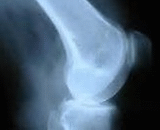Kaschin-Beck Disease (KBD)

Kashin–Beck disease (KBD) is a chronic, endemic type of osteochondropathy. KBD usually involves children ages 5–15. To date, more than a million individuals have suffered from KBD. The symptoms of KBD include joint pain, morning stiffness in the joints, disturbances of flexion and extension in the elbows, enlarged inter-phalangeal joints and limited motion in many joints of the body. Death of cartilage cells in the growth plate and articular surface is the basic pathologic feature; this can result in growth retardation and secondary osteoarthrosis. A model for rat Kashin-Beck disease induced by employing T-2 toxin treatment under selenium deficient conditions was established by researchers. Studies showed that increasing TBARS and decreasing antioxidants in serum and cartilage by T-2 toxin treatment with a selenium-deficient nutritional status may alter oxidative stress in joint tissues and contribute to the pathological process of cartilage damage in KBD.
Organism species: Mus musculus (Mouse)
- Disease model DSI588Mu01 Mouse Model for Kaschin-Beck Disease (KBD) In Stock
- Customized Service n/a Tissue of Kaschin-Beck Disease (KBD) (If Necessary) Tissue Customized Service Offer
- Customized Service n/a Serums of Kaschin-Beck Disease (KBD) (If Necessary) Serums Customized Service Offer
Organism species: Rattus norvegicus (Rat)
- Disease model DSI588Ra01 Rat Model for Kaschin-Beck Disease (KBD) In Stock
- Customized Service n/a Tissue of Kaschin-Beck Disease (KBD) (If Necessary) Tissue Customized Service Offer
- Customized Service n/a Serums of Kaschin-Beck Disease (KBD) (If Necessary) Serums Customized Service Offer
Organism species: Cavia (Guinea pig )
- Disease model DSI588Gu01 Cavia Model for Kaschin-Beck Disease (KBD) In Stock
- Customized Service n/a Tissue of Kaschin-Beck Disease (KBD) (If Necessary) Tissue Customized Service Offer
- Customized Service n/a Serums of Kaschin-Beck Disease (KBD) (If Necessary) Serums Customized Service Offer
Organism species: Oryctolagus cuniculus (Rabbit)
- Disease model DSI588Rb01 Rabbit Model for Kaschin-Beck Disease (KBD) In Stock
- Customized Service n/a Tissue of Kaschin-Beck Disease (KBD) (If Necessary) Tissue Customized Service Offer
- Customized Service n/a Serums of Kaschin-Beck Disease (KBD) (If Necessary) Serums Customized Service Offer
Organism species: Canis familiaris; Canine (Dog)
- Disease model DSI588Ca01 Canine Model for Kaschin-Beck Disease (KBD) In Stock
- Customized Service n/a Tissue of Kaschin-Beck Disease (KBD) (If Necessary) Tissue Customized Service Offer
- Customized Service n/a Serums of Kaschin-Beck Disease (KBD) (If Necessary) Serums Customized Service Offer
Organism species: Sus scrofa; Porcine (Pig)
- Disease model DSI588Po02 Porcine Model for Kaschin-Beck Disease (KBD) In Stock
- Customized Service n/a Tissue of Kaschin-Beck Disease (KBD) (If Necessary) Tissue Customized Service Offer
- Customized Service n/a Serums of Kaschin-Beck Disease (KBD) (If Necessary) Serums Customized Service Offer
Organism species: Chicken (Gallus)
- Disease model DSI588Ga01 Gallus Model for Kaschin-Beck Disease (KBD) In Stock
- Customized Service n/a Tissue of Kaschin-Beck Disease (KBD) (If Necessary) Tissue Customized Service Offer
- Customized Service n/a Serums of Kaschin-Beck Disease (KBD) (If Necessary) Serums Customized Service Offer


